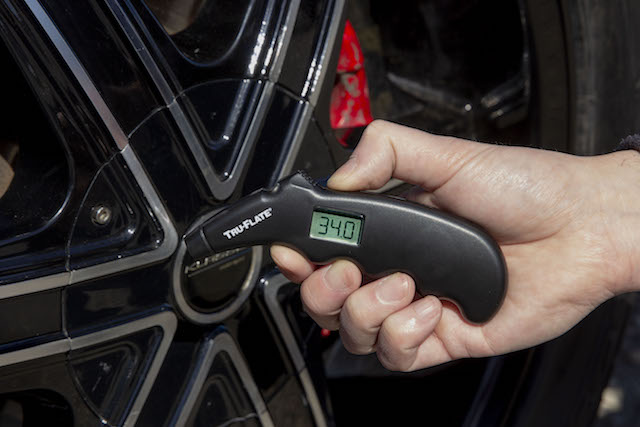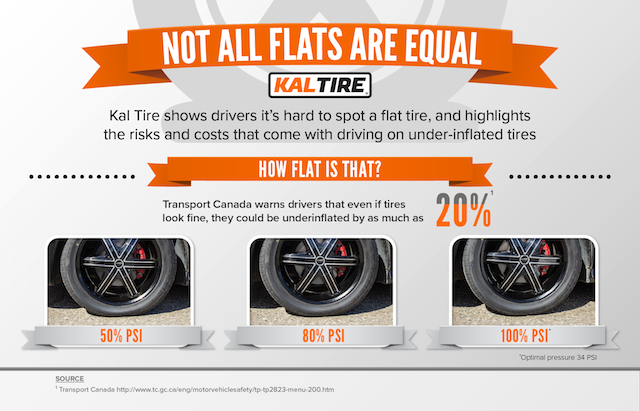How to Check Tire Pressure
When I was growing up in Metro Vancouver, every summer my family would embark on road trips. We’d get up to Barkerville, over to Fort Steele, and we even drove the Bella Coola Highway in the 1990s (and got the “I survived the Bella Coola Highaway” postcard to commemorate the feat.
Getting prepared for a road trip always started with the car; washer fluid, a full tank of gas, snacks of course, and checking the tire pressure on the family vehicle. Now, when I go on road trips of my own, I go through the same check-list.
For drivers heading out on road trips, under-inflation could spell sloppy handling and poor fuel economy at best, and the possibility of blowouts at worst. As warm weather and the open road beckons, Kal Tire is reminding Canadians to use more than just your eyes to check tire inflation.
How to Check Tire Pressure
Here are 5 simple steps you can take to check your tire pressure:
STEP 1. FIND THE RECOMMENDED PRESSURE FOR YOUR TIRES
Here are some of the places where you can find the manufacturer’s recommended tire pressure:
- On a sticker on the driver’s side door jam
- In your owner’s manual
- The trunk lid, the console or on the fuel door
- The number you find might look something like ‘35 PSI’ (pounds per square inch), and it indicates the minimum amount of air pressure needed to support the weight of your vehicle.
It’s very important that you do not use the ‘MAX PSI’ listed on the sidewall of the tire. This is the maximum pressure, not the optimum or recommended pressure.
STEP 2. CHECK AT THE RIGHT TIME
The ideal time to check your tires is when they’re cold, either first thing in the morning or after the vehicle has been parked for a few hours, in the shade if possible. If your tires are warm from driving, you’ll get a less accurate reading.
STEP 3. USE A RELIABLE GAUGE TO CHECK YOUR TIRE PRESSURE
- Remove the valve cap on the tire.
- Press the tire gauge onto the valve. (If you’re using a stick gauge, make sure you’re using the open end, not the side that releases air).
- Wait for the pressure reading on the screen. (On a stick gauge, wait until the white plastic stick stops moving; on a dial gauge, wait for the needle to stop).
STEP 4. INFLATE TIRES AS NEEDED
Now that you have your reading, you can compare it to the manufacturer’s recommended tire pressure. Add just enough to achieve the recommended air pressure. If you’ve added too much, push on the metal stem in the center of the valve to release air. Check the reading again and repeat if necessary. Don’t forget to put the valve cap back on the tire!
Note: If your tires are seriously under-inflated (25% or more), do not drive on them to fill up with air.
STEP 5. REMEMBER YOUR SPARE
Last but not least, after you check and inflate all four of your tires, do the same for your spare to ensure it’s ready to perform in the event of a flat tire.
Transport Canada warns drivers that even if tires “look fine, they could be underinflated by as much as 20 per cent.” And it turns out a lot of Canadians could be experiencing that safety risk: In a study referenced by Transport Canada, “50 per cent of vehicles on the road in Canada have at least one tire that is either over or under-inflated by more than 10 per cent. In fact, 10 per cent of all vehicles surveyed had at least one tire under-inflated by 20 per cent.”
Due to today’s technology, it’s harder than ever to spot a low-pressure tire just by looking at it. Tire pressure monitoring systems warn drivers about under-inflation but typically not until tire pressure is 25% below recommended levels – this is a dangerous level when risks of blowouts and accidents become higher.
The best course of action is to monitor tire pressure throughout the year – not just ahead of the next road trip or when your monitoring system blinks. Kal Tire recommends checking at the outset of every trip, but it’s also good to get in the habit of checking once a month or even every time you fill up with gas.
If you ever want a second opinion or expert help checking your air pressure or inflating your tires, visit a Kal Tire location near you. They’ll gladly measure your pressure and fill your tires with air for free!
Learn more by connecting with Kal Tire on Facebook, Twitter, Instagram and YouTube.













